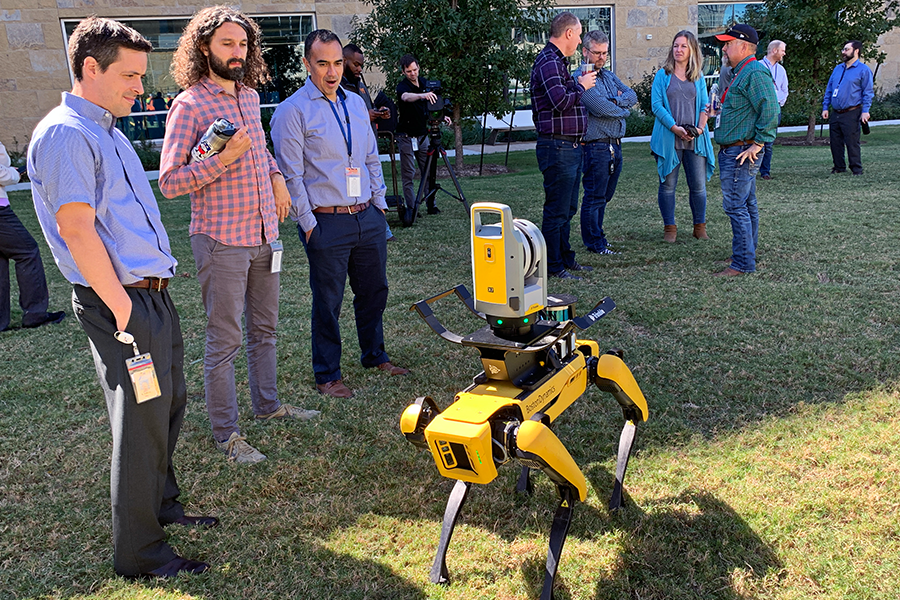- September 13, 2024
Next gen innovation

By Kelly E. Lindner
Science fiction is quickly becoming reality in life — but it’s also just another day on the job site at TxDOT.
If you’ve ever visited a TxDOT job site, don’t be alarmed if you notice a robotic worker. There’s TyBOT the rebar-tying robot in the Odessa area, Spot, the data-collection robot in Austin, and WALL-E the storm-drain inspection robot in the Austin area.
“There are unknown hazards sometimes that are in storm drains and covets, like snakes, rats and debris, so we would send WALL-E in vs. sending someone else in, being in danger and getting hurt,” said John Gordon, storm drain inspector at TxDOT.
These innovative machines are helping TxDOT be safer and more efficient in areas from construction to inspections.
“The idea of having a tool like this within the department is truly to keep us as safe as possible. It is completely safety driven,” said Matthew Bryant with TxDOT’s engineering services team.
TxDOT used TyBOT, a rebar-tying robot from Advanced Construction Robotics, for the first time in May 2022 on the SH 302 Highway Project in Winkler County in the Odessa area.
The project constructed two overpasses for the highway. One was over the Texas-New Mexico Railroad. The other was over SH 115, eliminating a four-way stop that caused traffic and safety issues.
“TyBOT makes it safer for workers,” said Saul Romero, director of construction in Odessa. “TyBOT allows one operator to stand upright and tie the rebar using a joystick.”
TyBOT can tie up to 1,100 rebar connections per hour. The robot doesn’t just save time, it also saves wear and tear for workers, since tying rebar can be hard on knees, hands and backs.
“It’s back-breaking work to tie steel, literally,” Romero said. “It’s much better and faster to have just one worker controlling the TyBOT with a joystick while standing upright instead of a crew tying rebar manually.”
Spot, created by Boston Dynamics, is a semi-autonomous, agile robot that assists with routine inspection and data collection tasks safely and accurately.
Spot can collect data for 3D models, inventory existing structures, account for existing assets, provide a clear picture of job site progress on an ongoing basis and much more. Spot can be outfitted with sensors to meet mission requirements, such as light detection and ranging sensors.
“Spot enables accurate, scalable and rapid data collection and a continuous flow of information between field and office,” Bryant said. “It can be 100% automated or remotely operated depending on the application.”
Once Spot surveys a specific area, it can routinely inspect or gather data automatically in that space on its own at programmed times.
“I can train someone to use Spot and collect data in 15 minutes,” Bryant said.
Spot also navigates the terrain with above-average agility. Using 360-degree perception, it navigates around obstacles – even new ones.
“If someone puts a box in its way or drives a bulldozer in front of it, it’ll walk around it,” Bryant said.
Spot can also balance heavy loads – close to 30 pounds – while rolling over uncertain terrain like loose gravel, grass, small puddles and curves. Spot can even handle stairs with steps up to 12 inches high and inclines up to 30 degrees.
“Spot keeps engineers and technicians out of harm’s way,” Bryant said. “Instead of putting on special gear and crawling into a drainage ditch or tunnel – which can contain snakes and other hazards – TxDOT employees could send Spot at no risk to themselves,” Bryant said. “We can also collect data we’ve never had before. Because of hazardous conditions, we have a lot of assumed data, but we’d be able to collect all the data we need – some of it for the first time. This will help accelerate our projects.”
The division expects to purchase two Spot units this spring.
“We plan to name one TX and the other DOT,” Bryant said.

